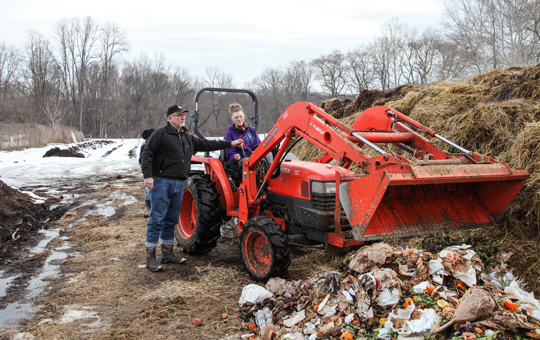Scott Blunk teaches Theresa Harter, a junior, how to work a loader at W.B. Saul High School in Roxborough. | Photos by Stephen Dyer
Compost expert and volunteer teacher makes educational programs possible for high school students
The compost pile at W.B. Saul High School in Roxborogh is about the size of a school bus—and that’s a good thing. When Scott Blunk, a volunteer for the agricultural high school’s compost operation, started working in September of 2011, he says the compost pile was 10 times the size.
“This is my laboratory; this is where the magic happens,” says Blunk, staring over the heap of composting animal waste, hay, egg cartons, fruit and vegetable skins, and even old jeans.
Saul’s compost operation, in collaboration with Weavers Way Co-op, has not only shrunk the pile, but turned the previously unused compost into a business. Students for the magnet school, one of the largest agricultural farm schools in the U.S., package the compost to sell to urban farmers or help grow crops for the school’s Community Supported Agriculture (CSA).
In the corner of its 130-acre campus, near where the cows and goats are kept, sits the machine that makes this all possible—a large piece of equipment that, when attached to a tractor, turns and chops up the organic waste. Years ago, the school stopped using the machine after it broke twice and no one knew how to fix it. But Blunk, who has worked for multiple agricultural companies and had helped his father with various fix-it projects, was able to get it up and running in 2011.
“Scott figured out something that needed to be done and did it,” says Mary Sweeten, editor of the Weavers Way newspaper, The Shuttle. She met Blunk in 2011 at Weavers Way when Blunk and his wife, a Temple professor, moved to Philadelphia after living in Illinois for over 20 years.
Down the hill from the composting equipment is the unturned pile with waste from the school’s farm, Bennett Compost and the Philadelphia Zoo. The main heap is one of many called windrows—compost piles in different stages of decomposition that are “cooking” before they can be used.
“I do it because it’s good for me, it keeps me busy and close to the earth,” Blunk says, referring to his time volunteering. “I feel good. I’m tired at the end of the day.”
But even more than maintaining the compost heap, Blunk likes doing hands-on projects with students that can’t be done in the classroom.
“Him working here has transformed what the kids are learning,” says Jessica McAtamney, an urban gardening and environmental science teacher at Saul. “With him, we’ve been able to add a lot of programs.”
These programs include a tractor safety class that Blunk became certified to teach, a lesson in assembling a greenhouse using the Pythagorean theorem (really!) and learning about fixing machinery by putting a wheelbarrow back together. When the students complete these projects, Blunk says they are learning soft skills such as sticking with a job until it’s done, problem-solving and customer service, which they can apply on other “real world” projects, including building solar panels, a program Saul would like to start. “It’s really about the kids,” Blunk says. “It’s fun






this can help for environment and as well as students belongs to that school. great work (y)